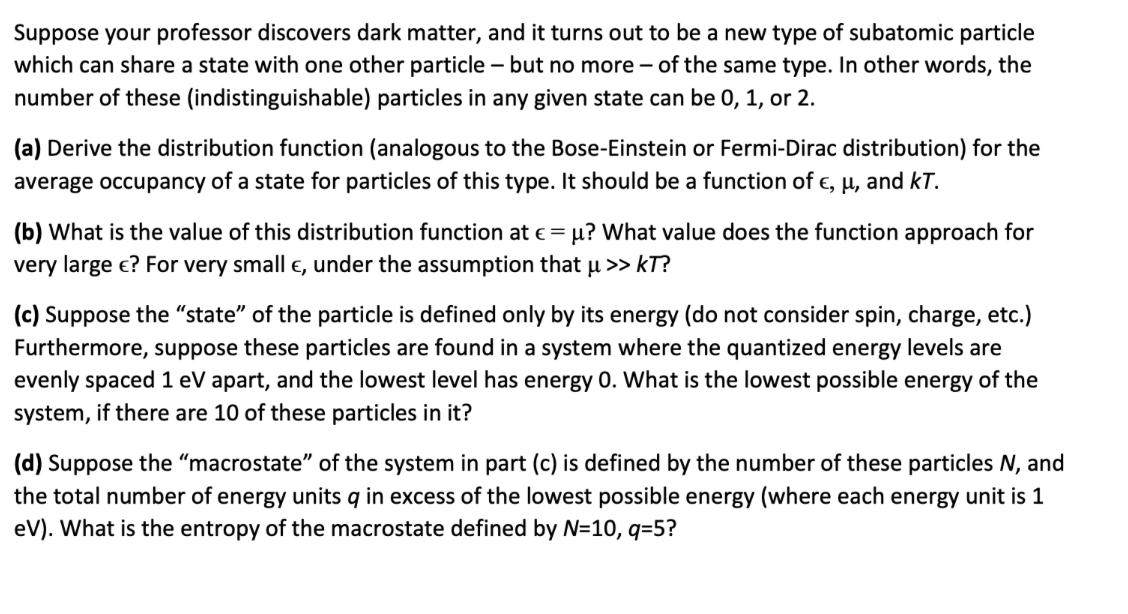Suppose your professor discovers dark matter, and it turns out to be a new type of subatomic particle which can share a state with one other particle – but no more – of the same type. In other words, the number of these (indistinguishable) particles in any given state can be 0, 1, or 2. (a) Derive the distribution function (analogous to the Bose-Einstein or Fermi-Dirac distribution) for the average occupancy of a state for particles of this type. It should be a function of e, µ, and kT. (b) What is the value of this distribution function at e = u? What value does the function approach for very large e? For very small e, under the assumption that u >> kT? (c) Suppose the "state" of the particle is defined only by its energy (do not consider spin, charge, etc.) Furthermore, suppose these particles are found in a system where the quantized energy levels are evenly spaced1 eV apart, and the lowest level has energy 0. What is the lowest possible energy of the system, if there are 10 of these particles in it? (d) Suppose the "macrostate" of the system in part (c) is defined by the number the total number of energy units q in excess of the lowest possible energy (where each energy unit is 1 eV). What is the entropy of the macrostate defined by N=10, q=5? hese particles N, and
Suppose your professor discovers dark matter, and it turns out to be a new type of subatomic particle which can share a state with one other particle – but no more – of the same type. In other words, the number of these (indistinguishable) particles in any given state can be 0, 1, or 2. (a) Derive the distribution function (analogous to the Bose-Einstein or Fermi-Dirac distribution) for the average occupancy of a state for particles of this type. It should be a function of e, µ, and kT. (b) What is the value of this distribution function at e = u? What value does the function approach for very large e? For very small e, under the assumption that u >> kT? (c) Suppose the "state" of the particle is defined only by its energy (do not consider spin, charge, etc.) Furthermore, suppose these particles are found in a system where the quantized energy levels are evenly spaced1 eV apart, and the lowest level has energy 0. What is the lowest possible energy of the system, if there are 10 of these particles in it? (d) Suppose the "macrostate" of the system in part (c) is defined by the number the total number of energy units q in excess of the lowest possible energy (where each energy unit is 1 eV). What is the entropy of the macrostate defined by N=10, q=5? hese particles N, and
Modern Physics
3rd Edition
ISBN:9781111794378
Author:Raymond A. Serway, Clement J. Moses, Curt A. Moyer
Publisher:Raymond A. Serway, Clement J. Moses, Curt A. Moyer
Chapter7: Tunneling Phenomena
Section: Chapter Questions
Problem 16P
Related questions
Question

Transcribed Image Text:Suppose your professor discovers dark matter, and it turns out to be a new type of subatomic particle
which can share a state with one other particle – but no more – of the same type. In other words, the
number of these (indistinguishable) particles in any given state can be 0, 1, or 2.
(a) Derive the distribution function (analogous to the Bose-Einstein or Fermi-Dirac distribution) for the
average occupancy of a state for particles of this type. It should be a function of e, µ, and kT.
(b) What is the value of this distribution function at e = u? What value does the function approach for
very large e? For very small e, under the assumption that u >> kT?
(c) Suppose the "state" of the particle is defined only by its energy (do not consider spin, charge, etc.)
Furthermore, suppose these particles are found in a system where the quantized energy levels are
evenly spaced1 eV apart, and the lowest level has energy 0. What is the lowest possible energy of the
system, if there are 10 of these particles in it?
(d) Suppose the "macrostate" of the system in part (c) is defined by the number
the total number of energy units q in excess of the lowest possible energy (where each energy unit is 1
eV). What is the entropy of the macrostate defined by N=10, q=5?
hese particles N, and
Expert Solution
This question has been solved!
Explore an expertly crafted, step-by-step solution for a thorough understanding of key concepts.
Step by step
Solved in 5 steps with 5 images

Knowledge Booster
Learn more about
Need a deep-dive on the concept behind this application? Look no further. Learn more about this topic, physics and related others by exploring similar questions and additional content below.Recommended textbooks for you

Modern Physics
Physics
ISBN:
9781111794378
Author:
Raymond A. Serway, Clement J. Moses, Curt A. Moyer
Publisher:
Cengage Learning

Classical Dynamics of Particles and Systems
Physics
ISBN:
9780534408961
Author:
Stephen T. Thornton, Jerry B. Marion
Publisher:
Cengage Learning

University Physics Volume 3
Physics
ISBN:
9781938168185
Author:
William Moebs, Jeff Sanny
Publisher:
OpenStax

Modern Physics
Physics
ISBN:
9781111794378
Author:
Raymond A. Serway, Clement J. Moses, Curt A. Moyer
Publisher:
Cengage Learning

Classical Dynamics of Particles and Systems
Physics
ISBN:
9780534408961
Author:
Stephen T. Thornton, Jerry B. Marion
Publisher:
Cengage Learning

University Physics Volume 3
Physics
ISBN:
9781938168185
Author:
William Moebs, Jeff Sanny
Publisher:
OpenStax

Foundations of Astronomy (MindTap Course List)
Physics
ISBN:
9781337399920
Author:
Michael A. Seeds, Dana Backman
Publisher:
Cengage Learning

Principles of Physics: A Calculus-Based Text
Physics
ISBN:
9781133104261
Author:
Raymond A. Serway, John W. Jewett
Publisher:
Cengage Learning